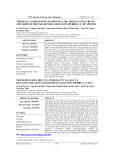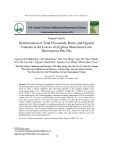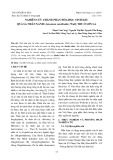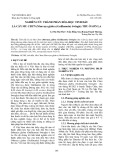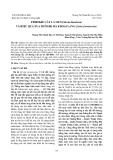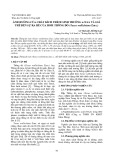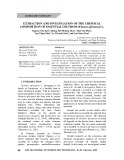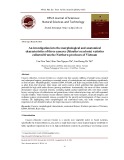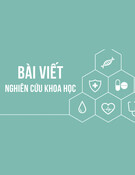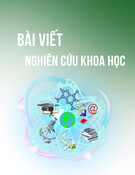
Vietnam Journal
of Agricultural
Sciences
ISSN 2588-1299
VJAS 2024; 7(1): 2064-2075
https://doi.org/10.31817/vjas.2024.7.1.05
2064
Vietnam Journal of Agricultural Sciences
Received: December 16,
2022
Accepted: March 6, 2024
Correspondence to
nttnga@vnua.edu.vn
ORCID
Nguyen Thi Thu Nga
http://orcid.org/0000-0003-0760-
2031
Polyphenols from Tropical Almond Leaves
(Terminalia catappa L.): Optimized
Extraction Conditions and α-Glucosidase
Inhibitory Activity
Nguyen Thi Thu Nga*, Nguyen Xuan Bac, Vu Thi Hanh & Lai
Thi Ngoc Ha
Faculty of Food Science and Technology, Vietnam National University of Agriculture,
Hanoi 131000, Vietnam
Abstract
The purpose of this study was to find the optimal conditions for
extracting polyphenols from Vietnamese tropical almond leaves
(Terminalia catappa L.) and to assess the anti-diabetic activities
of the resulting extract. The polyphenol extraction from
Vietnamese tropical almond leaves was optimized using the
response surface methodology. A rotatable central composite
design (RCCD) with three variables (ethanol concentration,
temperature, and extraction time), consisting of 21 experimental
runs with three replicates at the center, minimal, and maximal
factorial points was applied to describe the experimental data. The
experimental results properly confirmed the constructed model (R2
= 0.8337). The optimized conditions were as follows: ethanol
concentration of 62.76%, a temperature of 62.2°C, and an
extraction time of 70 minutes. Five extractions were performed in
parallel at the optimized conditions to validate the model. The
experimental values highly agreed with the predicted value. The
extract powder has powerful effects against the α-glucosidase
activity and can develop as a novel natural anti-diabetic agent.
Keywords
Tropical almond, polyphenol, α-glucosidase, antioxidant, anti-
diabetic
Introduction
Polyphenol compounds are the most common group of secondary
metabolites in the plant kingdom, with approximately 10,000
structures identified up to now (Kennedy & Wightman, 2011; Sridhar
et al., 2021). It was suggested that polyphenols are the most abundant
antioxidants in the human diet (Mudgal et al., 2010) and contribute
up to 90% of the total antioxidant capacity in most fruits and
vegetables (Wu et al., 2004).

Nguyen Thi Thu Nga et al. (2024)
https://vjas.vnua.edu.vn/
2065
A recent study showed that the leaves of
tropical almond collected in Vietnam have a high
polyphenol content of 1,709.75 ± 1.99 mg
GAE/g dried matter (Ha Dang Huy et al., 2021),
and is much higher than berries, which are
considered a source of polyphenols in the human
food. Polyphenol-rich extracts from the tropical
almond leaf demonstrated antioxidant, anti-
inflammatory, antibacterial, anti-cancer, and
hepatoprotective properties (Anand et al., 2015).
The tropical almond (Terminalia
catappa L.) is one of the recent objects of
researcher’s interest as a highly polyphenol-
containing object used in herbal medicines. The
tree belongs to the family Combretaceae, which
originates from Southeast Asia and is well-
developed in tropical and subtropical climates.
The tree can grow in arid, rocky places and is
usually planted in urban areas, roadsides,
temples, pagodas, and schools for landscaping
and shade (Do Huy Bich et al., 2006). Tropical
almonds are very popular in Vietnam, but their
utility is limited. The leaves are used to wrap
food and to treat fever, sweating, dysentery,
scabies, and tooth decay in traditional medicine;
they are also used as an alternative to antibiotics
to treat bacteria and fungi on ornamental fish
(Rex, 2019).
There have been several studies on the
extraction of the active ingredient from tropical
almonds (Ha Dang Huy et al., 2021; Vo Thi
Thanh Kieu, 2016); however, the optimal solvent
extraction conditions of polyphenols have not
been reported yet. This study optimized the
extraction parameters of polyphenols from
tropical almond (T. catappa L.) leaves and
evaluated the anti-diabetic properties of the
afforded extract.
Materials and Methods
Plant material preparation
The green tropical almond leaves collected
in Gia Lam province (Figure 1) were then dried
at 50°C by a forced air convection oven until
moisture content was less than 10%. This drying
temperature was defined based on our
preliminary experimentation (data not shown).
Dried tropical almond leaves were ground to
powder (below 0.12mm in diameter) and then
preserved in zip bags with a desiccant inside at
4oC. The material powder was extracted with
different sets of material-to-solvent ratios,
ethanol concentrations, extraction temperatures,
and times.
The extract obtained at the optimal
extraction conditions was evaporated by Buchi
Rotavapor R-210 (Buchi Labotechnik AG,
Switzerland) at 40°C under pressure of 175mbar
and lyophilized at -50°C with pressure of
0.45mbar by Thermo Scientific ModulyoD
Freeze Dryer (Thermo Fisher Scientific, US) to
analyze α-glucosidase inhibitory ability.
Chemicals and reagents
Gallic acid, Folin-Ciocalteau reagent, 6-
hydroxy - 2, 5, 7, 8 - tetramethylchroman - 2-
Figure 1. Green tropical almond leaves

Polyphenols from tropical almond leaves: Optimized extraction conditions and α-glucosidase inhibitory activity
2066
Vietnam Journal of Agricultural Sciences
carboxylicacid (Trolox), diphenyl-1-
picrylhydrazyl (DPPH) radical, enzyme yeast a-
glucosidase; p-nitrophenyl-α-D-glucopyranoside
(pNPG), 4-Nitrophenol were purchased
from Sigma-Aldrich (St. Louis, MO, USA).
Na2CO3, ethanol, and methanol of analytical
grade were obtained from Xilong, China.
Single-factor experiment
The material powder used to extract with five
different sets of material-to-solvent ratios from 1/5
to 1/25, at seven different concentrations of 20, 40,
50, 60, 70, 90, and 96% of ethanol solvent, at seven
different extraction temperatures from 40 to 95°C
and for six extraction times (from 30 to 120
minutes) in an incubator shaker with a shaking
speed of 150 rounds/min. All the solutions were
then transferred to 50-mL falcon tubes and
centrifuged at 6000 rounds/min for 10 minutes at
4°C. The collected supernatants were used to
analyze total polyphenol. The impact of material-
solvent ratio, ethanol concentration, extraction
temperature, and extraction time on total
polyphenol content (TPC) was evaluated to
identify the suitable ranges of parameters for
optimizing polyphenol extraction from tropical
almond leaves (Table 1). All the extraction
processes were carried out in three replicates,
and all the analyses on each sample were done
in duplicate.
Optimization of polyphenol extraction by
Response Surface Methodology (RSM)
The polyphenols extraction from tropical
almond leaves was further optimized through the
response surface methodology (RSM) approach.
The design variables were the ethanol
concentration (X1), extraction temperature (X2),
and extraction time (X3) at five different levels
assigned to the obtained set of optimum
parameters (Table 2). A Rotatable Central
Composite Design (RCCD) consisted of 21
experiment runs with eight factorial points, six
axial points, and three replicates at the center
point, maximal and minimal factorial points.
Those combinations then experimentally
attempted to obtain the data of Y, which then
fitted to the following second-order
polynomial model:
Y = 𝛽0+ ∑𝛽𝑖
3
𝑖=1 Xi + ∑𝛽𝑖𝑖𝑋𝑖𝑖
2
3
𝑖 +
∑ ∑ 𝛽𝑖𝑗
3
𝑗=1
3
𝑖=1 𝑋𝑖𝑋
𝑗
When
Y: the response variable (total polyphenol)
X: independent variables
β: model coefficients
0, i, j, and ij: the constant, linear terms,
quadratic terms, and interactive terms
The optimal conditions of the TPC
extraction process were determined using JMP
10 software. The experiment & predicted values
of five replicates performed at the optimal
conditions were compared to validate the model.
Determination of total polyphenol content
The polyphenol content of the extract was
determined using the Folin-Ciocalteu reagent as
described by Singleton & Rossi (1965). First, an
aliquot of 0.5mL diluted extract was mixed with
0.25mL Folin-Ciocalteu reagent 1N. The mixture
was shaken and then allowed for a reaction for 5
minutes at room temperature 25°C. Then,
1.25mL Na2CO3 7.5% was added and mixed
well. After incubation at room temperature 25°C
for 30 minutes, the absorbance of the reaction
Table 1. Single-factor experiment on total polyphenol content
Experiment
Extraction parameters
Fixed parameters
Material-to-solvent ratio (g/mL)
1/5, 1/10, 1/15, 1/20, 1/25
Ethanol 70%, 40°C, 60 minutes
Ethanol concentration (%)
20, 40, 50, 60, 70, 90, and 96
Selected material-to-solvent ratio, 40°C,
60 minutes
Extraction temperature (°C)
40, 50, 60, 70, 80, 90 and 95
Selected material-to-solvent ratio,
selected ethanol concentration, 60
minutes
Extraction time (minute)
15, 30, 45, 60, 90, and 120
Selected material-to-solvent ratio,
selected ethanol concentration, selected
extraction temperature

Nguyen Thi Thu Nga et al. (2024)
https://vjas.vnua.edu.vn/
2067
Table 2. The response surface methodology experimental
Factor
Symbol
Coded level
EtOH concentration (%)
X1
-1.68
-1
0
+1
+1.68
Temperature (°C)
X2
-1.68
-1
0
+1
+1.68
Time (minute)
X3
-1.68
-1
0
+1
+1.68
solution was measured at 755nm by UV-1800
UV-VIS spectrophotometer (Shimadzu, Japan).
Gallic acid was used as the standard for building
calibration curves. The TPC was expressed as mg
of gallic acid equivalent (GAE) per gram dry
weight (mg GAE/g DW).
Determination of α-glucosidase inhibitory
ability
The extract powder was sent to the
Biological test laboratory, Institute of
Biotechnology, Vietnam Academy of Science
and Technology to determine the α-glucosidase
inhibitory ability. The α-glucosidase enzyme
inhibitory activity of the extract powder
performed as follows:
First, extract powder was dissolved in
DMSO 100% (v/v) to obtain 20 mg mL-1
concentration and diluted in phosphate buffer
10 mM (pH = 6.8). The reaction mixture
containing 130μL of phosphate buffer (100mM,
pH = 6.8), 20μL of the enzyme α-glucosidase
(0.5 U/mL), and 50μL of the extract dilution
was incubated at 37°C for 15 minutes to obtain
final concentration at 500-100-20-4 µg mL-1.
Then, 40μL of p-nitro-phenyl-α-D
glucopyranoside (5mM) was added to the above
mixture and kept at 37°C for 60 minutes. The
reaction stopped by adding 80μL of Na2CO3
(0.2M). The absorbance of the released p-
nitrophenol was measured at 405nm by an
ELISA Plate Reader (Biotek). Acarbose, a
commercial α-glucosidase inhibitor that is
considered a first-line treatment for diabetic
individuals used as the standard.
The α-glucosidase inhibitory activity of the
extracts was calculated by the formula: %
inhibitory activity = 100 – absorbance of
sample/absorbance of control*100.
IC50 was defined by TableCurve2Dv4.
Statistical analysis
The experiment results were expressed as
mean ± standard deviation (SD) and analyzed
using the SAS 9.4 software (SAS Institue, Cary,
NC). One-way analysis of variance (ANOVA)
and the Duncan test were used to determine the
differences among the means at P-value <0.05.
In the RSM experiment, multiple linear
regression analysis was performed using the
software JMP 10 (SAS Institue, Cary, NC).
Results and Discussion
Single-factor experiment
Effect of material-to-solvent ratio
The material-to-solvent ratio showed a
significant effect on the TPC extraction (P <
0.05) (Figure 2). The total polyphenols yield
from the tropical almond extracts increased when
the ratio raised from 1/5 to 1/20 (w/v) and
remained stable at a further higher in the
material-to-solvent. This increase could be due to
the enhanced penetration of solvent through the
cell membrane under thermal treatment, which
helps push active compounds out, resulting in
greater extraction of materials by solvent
(Cacace & Mazza, 2003). However, the
component yield did not increase once
equilibrium was achieved (Herodez et al., 2003).
With the material-to-solvent ratio of 1/20 (w/v),
the TPC of the extract was at the maximum level,
indicating a sufficient amount of extraction
solvent used, and this ratio was chosen for the
consequent experiment.
Effect of ethanol concentration
The TPC of the extracts as a function of
ethanol concentration follows a parabolic shape,
and the ethanol concentration had a significant
effect (P <0.05) on the extraction efficiency of
total polyphenol from Vietnam’s tropical almond

Polyphenols from tropical almond leaves: Optimized extraction conditions and α-glucosidase inhibitory activity
2068
Vietnam Journal of Agricultural Sciences
Note: Values are means ± standard deviation. Values marked by different letters indicate significant difference (P <0.05)
Figure 2. Effect of material-to-solvent ratio on total polyphenol content of the extracts
leaf (Figure 3). The TPC gained from the extract
at 50% ethanol (93.46 mg GAE/g DW) was
significantly higher than those recovered at lower
ethanol concentrations (0, 20, and 40%). Rising
the ethanol concentration from 50 to 60%
slightly decreased the TPC yield to 91.07 mg
GAE/g DW, and with ethanol concentration
higher than 60%, the TPC of the extracts
significantly dropped (P <0.05). The impact of
the ethanol concentration could be due to its
effect on the polarity of the extraction solvent
and the resulting solubility of the polyphenol
compounds; It is interesting to note that the
numbers of water and ethanol are 1.000 and
0.654, respectively (Reichardt, 2003). The
polyphenols in the extracts increased with
increasing ethanol concentration according to the
like dissolves-like principle (Chirinos et al.,
2007). The highest total polyphenol content at
50% ethanol (v/v) indicated that the solvent had
similar polarity to polyphenols in tropical
almond leaves. And solvents higher than 60%
were not suitable polarities resulting in lowered
total polyphenols content. A solvent of 50%
ethanol (v/v) was chosen as the central value in
the RSM experiment.
Effect of temperature extraction
The extraction temperature significantly
affected the TPC extraction from tropical
almond leaves (Figure 4). Results indicated a
significant increase in the extraction of TPC
when the temperature elevated from 40 to
70°C, and a further temperature rise noticeably
downed the level of polyphenols in the extracts
(P <0.05). This effect of temperature followed
studies on glucosinolates extraction from by-
products of white cabbage (Nga, 2016). The
whole polyphenol extraction process could
speed up by the enhanced mass transfer with
the penetrated solvent into the plant matrix and
the increased solubility and diffusion
coefficient of polyphenol (Al-Farsi & Chang,
2007). However, extraction yields decreased
when the extraction temperature raised more
than 70°C, indicating that polyphenols in
tropical almond leaves are not thermo-
resistant phenolic compounds. This result
agreed with a previous report where 60°C
determined as the extraction temperature of
TPC of ethanolic rosemary leaf extract (Tam
et al., 2021).
The polyphenols level extracted at 60°C did
not significantly improve from that at 70°C (P >
45.91c
73.42b
88.07a90.16a91.17a89.32a
0
10
20
30
40
50
60
70
80
90
100
1/5 1/10 1/20 1/25 1/30 1/40
Total polyphenol content (mg GAE/g DW)
Material to solvent ratio (g mL-1)


